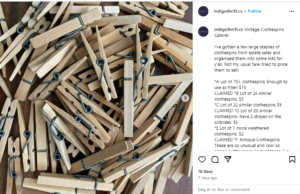Before technology made it possible for single socks to go to spinning hell, people were smarter and made tools to help them do even the hardest housework.
This wooden peg is one of those tools. It changed over time into a two-piece pin that held things to a line. This was a big improvement over the old model, which threw socks and other clothes into the wind, which was “a serious evil to washerwomen.”
Read on to find out more about this wooden tool!
Someone recently found some small wooden dowels with two legs online and asked for help on social media to figure out what they were.
A group of nostalgic boomers responded to the Facebook post with the answer, “Old school clothespins.” They were used to hang clean, wet clothes outside on the line to dry in the sun and fresh air!”
A clothespin, which is sometimes just called a “clothes peg,” is a traditional home item used to hang wet clothes on a clothesline to dry. These days, the pins are usually made up of two wooden pieces that are hinged together at one end. There is a spring system inside that gives the pins the tension they need to stick to clothing.

Ancient times
In the past, people used different ways to keep their clothes safe while they dried. This is where wooden clothespins come from.
They were very different from the wooden clothespins we use today. The first carved clothespins were made very long ago. The first clothespins were usually made by hand from natural materials like stone, bone, or wood, and they often had fancy designs or patterns on them.
The modern wooden clothespin as we know it today came about in the 1800s as people looked for an easier and more useful way to hang their clothes.
When clothespins were first made, they were made by hand from solid wood, usually maple or birch, and were made up of just two pieces of wood held together with a small metal wire or spring.

‘Evil to washerwomen’ and men
The current style we know today comes from a clothespin patent that David M. Smith from Vermont got in 1853.
His patent from October 25, 1853, says that the new clothespins “are hinged together” by a wire “so that the two longer legs may be moved toward each other and the shorter ones may be moved apart at the same time.”
When you squeeze the two pieces of wood together, they make a clamp. This makes it possible for the clothespin to hold clothes firmly without damaging them. The spring system in the clothespin keeps it closed when it’s not in use, so it can hold clothes securely even when it’s windy outside.
This is what Smith says in the patent: “Another advantage and a very important one too, [what] my improved clothes pin possesses over the common pin is that it cannot be detached from the clothes by the wind as is the case with the common pin and which is a serious evil to washerwomen.”
Evolving pins
During the 19th and early 20th centuries, as industry grew, more machines were used to make wooden clothespins. There were companies that made wooden clothespins that could make a lot of standard clothespins more quickly and for less money. This made wooden clothespins easier for more people to get, which is one reason why they are used so often for cleaning.

Even though clothespins made of plastic and other materials came out in the 20th century, wooden ones were still used in most homes around the world. They were popular for hanging clothes because they were easy to use, durable, and cheap. This was especially true for people who didn’t have access to modern drying technologies.
Today, wooden clothespins are still made and used in homes all over the world, either for hobbies or to dry clothes. They are loved for their nostalgic look and eco-friendliness.
Some places use more plastic clothespins because they are cheaper and easier to make in large quantities, but wooden clothespins are still a sign of traditional washing methods and eco-friendly living.
What’s worse, losing socks to the wind or in a dryer? Please SHARE this article with Family and Friends and let us know what you think in comments!